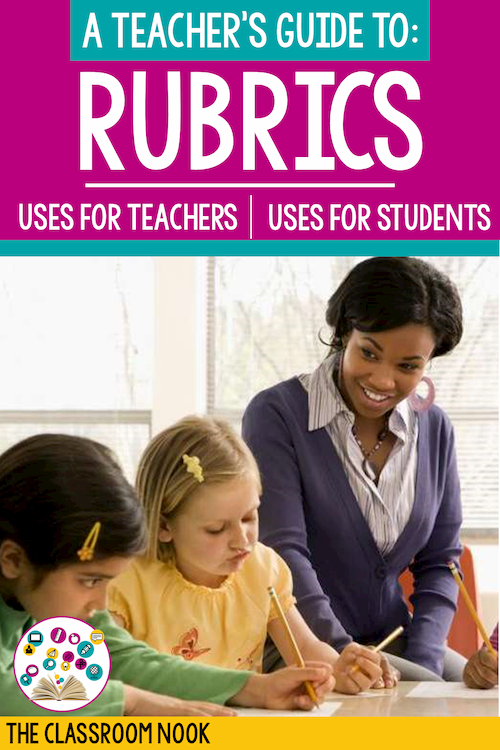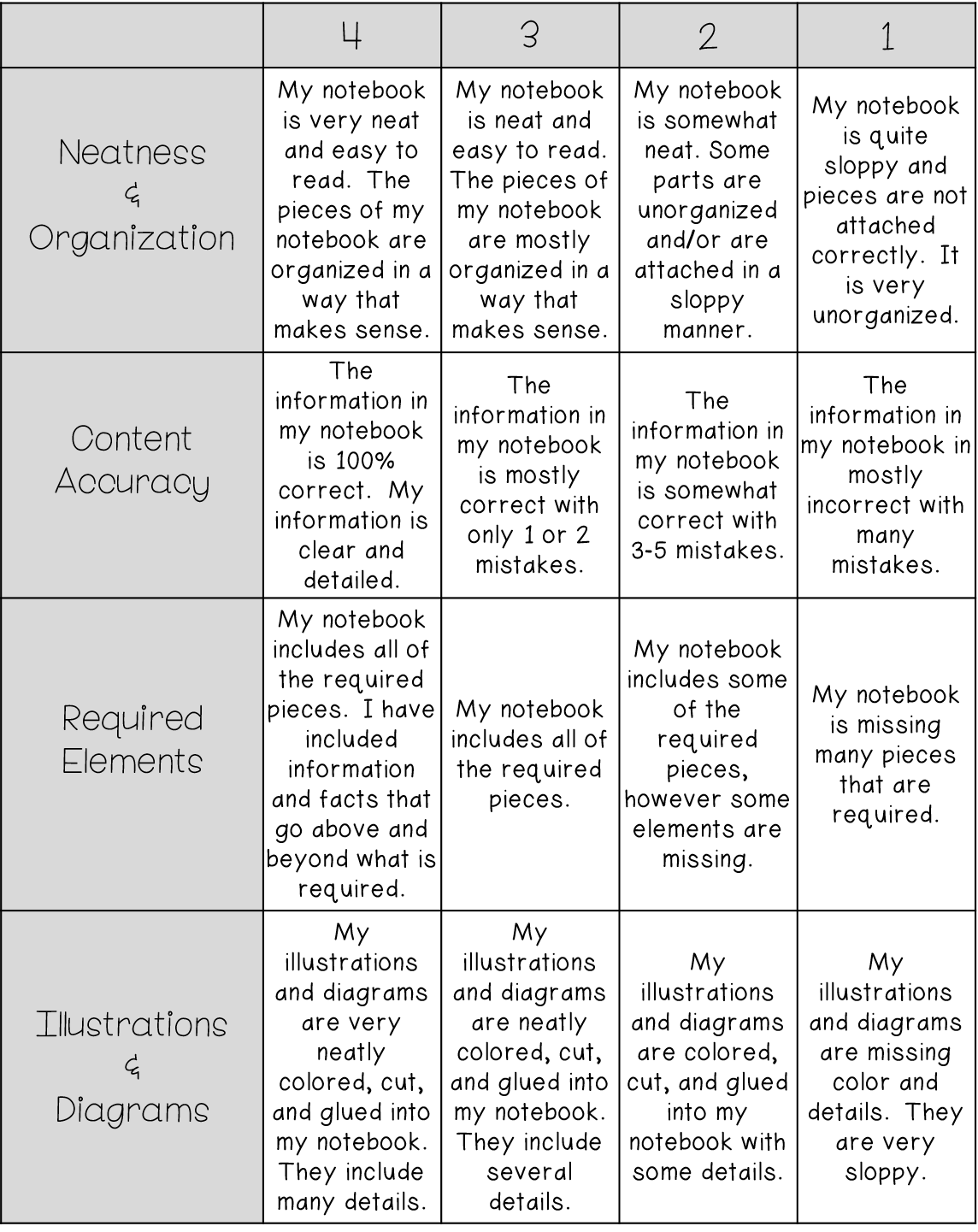Using Rubrics for Instruction and Assessment in the Elementary Classroom
Love podcasts? Check out this post in the form of a podcast episode on The Classroom Commute Podcast:

Assessment drives instruction. A reflective teacher looks at how his or her students are performing and crafts lessons and activities to meet their needs. Because of this, teacher need to make sure that the tools that they are using to assess their students are effective.
Rubrics are often a great assessment tool to use with students. However, rubrics can work double duty by not only providing an overall view of how students are performing, but they can also be an effective instructional tool for TEACHERS as well.
In this post, I want to take a deep dive into what rubrics are and how they can be used effectively as instructional AND assessment tools.
But first, let’s start with the basics.
What Are Rubrics?
Rubrics are a scoring tool that evaluate a student’s performance, understanding, and effort toward a certain skill or topic. Sometimes rubrics are used solely by the teacher, while other times the rubric is written in kid-friendly language so that students can understand the expectations given. This post is going to focus on the latter.
Rubrics explicitly outline the criteria and expectations for one or more categories as they relate to a particular assignment. Within each category are levels of quality, typically given a number rating (ex. 1-4) or a characteristic rating (ex. poor-excellent). Take a look at the rubric below for assessing a students understanding of the reading comprehensions strategy for asking questions:
On a sliding scale from 1-4, students are assessed on their ability to ask questions as they read. Each level of performance uses clear language that distinguished one level from the next. For example, notice the progression of words used to describe a student’s ability to use evidence from the text to support their questions. In level one, the word struggle is used. It then progresses to sometimes, to usually, to a confident I can use evidence. With each level, the standard is clearly outlined for the student. Typically, a student performing at level 4 is performing slightly above grade level, while 3 is performing on grade level, level 2 is slightly below grade level, and level 1 is significantly below grade level. Rubrics are great for creating consistency from student to student. Ideally, two teachers evaluating the same student should come up with the same score using the criteria of a rubric.
When used correctly, rubrics help both teachers and students.
Rubrics help teachers…
Guide Instruction - Teachers can use a rubric to see how their students are performing in a variety of categories and craft follow-up lessons and individual conferences to help their students improve
Save Time - After the initial work of creating a rubric is done, the rubric can used again and again to effectively assess their students year after year
Remain Consistency - By using the same criteria from student to student, teachers can assess each student using the same guidelines
Offer Clear Feedback - Rather than just giving students a grade (ex. 85% or B+), students can see exactly what they did well and where they need to improve.
Rubrics help students…
Take Ownership of Their Learning - Since rubrics clearly outline the criteria for each level, they can put forth effort to perform to the best of their ability.
Understand Expectations - When written in kid-friendly language, students can use the rubric to understand exactly what is required of them on all aspects of their assignment.
Take Steps Toward Improvement - When students see where they are currently performing and compare that to where they want to be, they can, along with your help, develop action steps to help them improve.
Rubrics work best for assignments that are subjective. On the other hand, objective assessment such as multiple choice, fill in the blank, or assessments that only have one answer are not ideal for rubrics. Use rubrics for:
Written Assignments (essays, summaries, narratives, opinion pieces, etc.)
Hands-On Projects (ex. create a shoe box biome or a poster for a specific topic)
Oral Presentations
Group Projects
Interactive Notebooks
Artistic Assignments
Assessing a students use of a reading skill or reading strategy
Assessing behavior (perfect as a classroom management strategy!)
Of course, this is not an exhaustive list, but hopefully gives you a jumping off point.
Using Rubrics as an Instructional Tool
Rubrics are, of course, an assessment tool, however, they can also be an effective instructional tool. To help set your students up for success, present the rubric to them before the assignment is given. This will set the expectations and clearly outline the assignment. Provide examples and models for all levels of the rubric so that students not only see the expectations in writing on the rubric, but also see those expectations put into action through a completed assignment. Plan ahead - if possible, keep or make copies of student work in varied levels of performance to use in future years. Remove or blackout student names, of course. Using real student work is a great way to provide authentic examples of each level for your students. However, if you are just getting started with rubrics, create your own examples until you have real ones from former students.
When appropriate, involve students in creating the rubric. This will help students “buy-in” to the process and even encourage them to take ownership in their learning. If you choose to do this, however, be sure it is after students have had multiple experiences with being assessed with a rubric. That way they will be familiar with the process. You might even provide them with a list of descriptor words that they can use in each level and category. Include words and phrases such as always, sometimes, usually, struggles, lacks, with/without assistance, detailed, simple, complex, in/correctly, many, several, and little. Avoiding using subjective words like interesting and creative, as this promotes assessing with an opinion.
Using Rubrics as an assessment Tool
Before assessing an assignment using a rubric, reread the entire rubric. This will help set intention and purpose going in to the grading process. On occasion, have a colleague assess the same assignment with the same rubric. Think of it as “quality control.” Be open to tweaking a rubric as needed to make it more clear.
For individual students, make note of follow-up teaching points that you’ll want to address during small groups or individual instruction times. Are there are few students that could benefit from the same follow-up lesson (based on the rubric)? Pull a small group to reteach or clarify a skill or strategy as needed. The ultimate goal of a rubric is for students to receive feedback that they can use to improve their performance. Use this small group or individual instruction time to give them actionable steps that will help them to do just that. Reference the language used in the rubric as much as possible when providing these action steps. Use phrasing like “in order to score a 3 in that category, you’ll need to…” or “The thing that’s keeping you from jumping up to the next level is…to get there, try…”
Look for trends across your class. Was there an area that many students scored lower on than expected? If so, perhaps that section of the rubric is unclear, or you need to reteach a certain skill.
When appropriate, have students use the rubric to assess themselves. This could be very eye-opening to how they view their ability and performance on a particular assignment. Discuss and compare your rubrics. Doing so will be a valuable conversation between you and your student.
Differentiating with RubricS
As with anything in our classroom, there are times when it is appropriate to differentiate. Rubric are no different.
One way to differentiate a rubric is to eliminate certain categories. Determine one or two goals that you’d like your student to focus on. Take the interactive notebook rubric, for example. If you have a student that struggles just create pages that are neat and organized (we’re talking pieces sticking out of the notebook, bent and crumpled, or parts of it glued down in any which way, and handwriting that makes you go cross-eyed!), it’s going to be difficult to even seen if they have accurate content. Focus on just the “Neatness & Organization” category for one particular assignment. Help them to get a handle on that before focusing on the other categories.
That’s not to see they aren’t being assessed on those categories, but when it comes to giving actionable steps that students can run with to improve their performance, narrow your focus for greater success in the long run.
Likewise, another way to differentiate is to eliminate the number of levels of performance. For example, If you know a student is not going to even come close to reaching a level 4 at this point on any given rubric, leave it off the rubric completely. This will take some of the overwhelm away and help students focus on what they can accomplish and be successful at.
On the other hand, if a student isn’t even registering on the rubric that you’ve already created, there’s no point in even using it with that particular student. Instead, create one that will actually help them improve. If a student has an IEP or other educational plan set in place, use the goals outlined there to develop a rubric that is a more accurate measure of their abilities.



